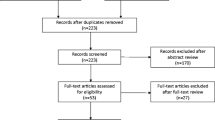Abstract
For bulking agents used for female stress urinary incontinence, the recommendation for the anatomical placement varies as some injectables are to be placed close to the bladder neck and others midurethrally. Aim of the study was to determine if there are differences concerning the outcome after transurethral collagen injections depending on the anatomical placement midurethrally or at the bladder neck. We randomly assigned 30 elderly female patients with urodynamic stress incontinence to either transurethral collagen injection midurethrally or to the bladder neck. Prior to injection and at ten month follow-up, maximum urethral closure pressure (MUCP), functional urethral length (FUL), maximum flow rate and cough test were performed and the patient was asked to estimate her bladder condition using a visual analogue scale. Postoperative contentness was 8 (median, 95% confidence interval 5–9) in the midurethral group and 8 (median, 95% confidence interval 7–10) in the bladder neck group with a p value of 0.012, 95% confidence interval –2.464 to –0.2859, in favour to midurethral injections. MUCP and FUL increased significantly in both groups and flow rate decreased in both groups. Continence was 66.6% in the midurethral group and 60% for the bladder neck group respectively. Both midurethral and bladder neck collagen injections improve patients’ satisfaction almost equally with a small advantage for midurethral injections.





Similar content being viewed by others
References
Keegan P, Atiemo K, Cody J, McClinton S, Pickard R (2007) Periurethral injection therapy for urinary incontinence in women Cochrane Database systematic Rev 18 (3):CD003881
Barranger E (2003) Results of transurethral injection of silicone micro-implants for female s with intrinsic sphincter deficiency. J Urol 164(5):1619–1622
Chrouser KL et al (2004) Carbon coated zirconium beads in beta-glucan gel and bovine glutaraldehyde cross-linked collagen injections for intrinsic sphincter deficiency: continence and satisfaction after extended follow up. J Urol 171:1152–1155
Bent AE et al (2001) Treatment of intrinsic sphincter deficiency using autologous ear chondrocytes as a bulking agent. Neurourol Urodyn 20(2):157–165
Haab F, Zimmern PE, Leach GE (1997) Urinary stress incontinence due to intrinsic sphincter deficiency: experience with fat and collagen periurethral injections. J Urol 157(4):1283–1286
van Kerrebroeck P et al (2004) Efficacy and safety of a novel system (NASH/Dx copolymer via the implant device) for the treatment of SUI. Urol 64(2):276–281
Monga AK, Robinson D, Stanton SL (1995) Periurethral collagen injections for genuine stress incontinence: a 2 year follow up. Br J Urol 75:156
Richardson TD, Kennelly MJ, Faerber GJ (1995) Endoscopic injection of glutaraldehyde cross linked collagen for the treatment of intrinsic sphincter deficiency in women. Urology 46(3):378–381
Pickard R (2003) Periurethral injection therapy for urinary stress incontinence in women Cochrane database syst review (2):CD 003881
Monga AK, Stanton SL (1997) Urodynamics—prediction, outcome and analysis of mechanism for cure of stress incontinence by periurethral collagen. Br J Obstet Gynaecol 104:158–162
McGuire EJ, English SF (1997) Periurethral collagen injection for male and female sphincteric incontinence: indications, techniques and result. World J Urol 15(5):306–309
McGuire E, Appell RA (1994) Transurethral collagen injection for urinary incontinence. Urology 43(4):413–415
Kim YH, Kattan MW, Boone TB (1997) Correlation of urodynamic results and urethral coaptation with success after transurethral collagen injection. Urology 50(6):941–948
Gorton E, Stanton S, Monga A, Wiskind AK, Lentz GM, Bland DR (1999) Periurethral collagen injection: a long term follow up study. BJU Int 84(9):966–971
MacKinney CD, Gaffey MJ, Gillenwater JY (1999) Bladder outlet obstruction after multiple periurethral polytetrafluoroethylene injections. J Urol 153(1):149–151
Albo ME, Richter HE, Brubaker L, Norton P, Kraus SR et al (2007) Burch colposuspension versus fascial sling to reduce urinary stress incontinence. N Engl J Med 356(21):2143–255
Burch JC (1961) Urethrovaginal fixation to Cooper’s ligament for correction of stress incontinence, cystocele and prolapse. Am J Obstet Gynecol 81:281–290
Ulmsten U, Henriksson L, Johnson P, Varhos G (1996) An ambulatory surgical procedure under local anaesthesia for treatment of female urinary incontinence. Int Urogynecol J Pelvic Floor Dysfunct 7(2):81–85
Petros PE, Ulmsten UI (1990) An integral theory of female stress urinary incontinence. Experimental and clinical considerations. Acta Obstet Gynecol Scand Suppl 153:7–31
Hagemeier T, Blau U, Gauruder-Burmester A, Tunn R (2006) Paraurethral abscess developing after midurethral Zuidex-injection in women with stress urinary incontinence. Zentralbl Gynakol 128(2):68–70
Colleselli K, Stenzl A, Eder R, Strasser H, Poisel S, Bartsch G (1998) The female urethral sphincter: a morphological and topographical study. J Urol 160(1):49–54
Rivas Da, Chancellor MB, Liu J-B, Hanau C Bagley DH, Goldberg B (1996) Endoluminal ultrasonographic and histologic evaluation of periurethral collagen injection. J Endourol 10(1):61–66
Conflicts of interest
None.
Author information
Authors and Affiliations
Corresponding author
Rights and permissions
About this article
Cite this article
Kuhn, A., Stadlmayr, W., Lengsfeld, D. et al. Where should bulking agents for female urodynamic stress incontinence be injected?. Int Urogynecol J 19, 817–821 (2008). https://doi.org/10.1007/s00192-007-0535-1
Received:
Accepted:
Published:
Issue Date:
DOI: https://doi.org/10.1007/s00192-007-0535-1



